Streaming has revolutionized underground metal music production by increasing accessibility and exposure for artists. It enables global distribution, fosters community engagement, and allows for innovative production techniques. However, challenges such as limited visibility and low revenue persist. This article explores how streaming shapes the future of underground metal, highlighting the balance between creative control and market demands.
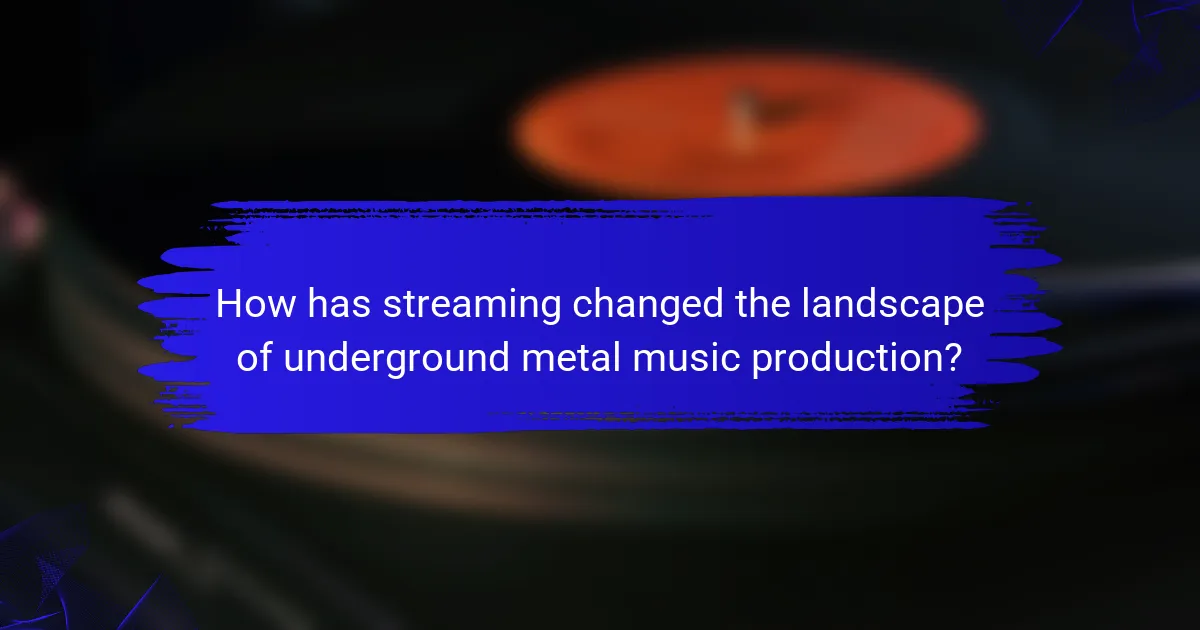
How has streaming changed the landscape of underground metal music production?
Streaming has significantly transformed underground metal music production by enhancing accessibility and exposure. Artists can now distribute their music globally without traditional barriers. This democratization allows for a diverse range of subgenres to flourish, as niche bands gain audiences they might not have reached otherwise.
The rise of platforms like Spotify and Bandcamp has shifted revenue models. Musicians often rely on streaming royalties, which, while lower than physical sales, provide consistent income opportunities. Additionally, these platforms enable direct fan engagement, fostering community around underground metal scenes.
Moreover, streaming analytics offer valuable insights into listener demographics and preferences. This data empowers artists to tailor their marketing strategies effectively. As a result, underground metal bands can cultivate loyal followings and adapt their sound based on real-time feedback.
The unique aspect of this transformation lies in the ability for underground artists to maintain creative control over their work. Unlike mainstream labels, many underground musicians choose to self-release, preserving their artistic integrity while leveraging streaming for broader distribution.
What are the key platforms influencing underground metal artists?
Streaming platforms significantly impact underground metal artists by providing accessible distribution and audience engagement. Services like Bandcamp, Spotify, and SoundCloud allow artists to share their music widely without traditional label constraints.
Moreover, these platforms enable data-driven insights, helping artists understand listener demographics and preferences. This information can inform marketing strategies and music production decisions.
Additionally, social media integration on these platforms fosters community building among fans and artists, creating a supportive ecosystem for underground metal scenes.
Overall, streaming democratizes music production, empowering underground metal artists to reach global audiences while maintaining creative control.
How does streaming affect the financial viability of underground metal bands?
Streaming significantly impacts the financial viability of underground metal bands by offering both exposure and revenue challenges.
With platforms like Spotify and Bandcamp, bands can reach wider audiences without traditional barriers. However, streaming royalties are often low, making it difficult for these artists to sustain themselves financially. The average payout per stream is around $0.003 to $0.005, which means that bands need millions of streams to earn a livable income.
Moreover, underground bands often rely on merchandise sales and live performances for revenue, as streaming alone typically does not cover costs. As a result, while streaming can enhance visibility, it may not provide sufficient financial support, leading to a precarious situation for many artists in this genre.
What role does social media play in promoting underground metal through streaming?
Social media significantly enhances the visibility of underground metal by facilitating direct artist-fan interactions. Platforms like Instagram and Facebook allow bands to share music, promote events, and engage with niche communities. This accessibility fosters a loyal fan base that might not find traditional promotion avenues. Streaming services amplify this effect by providing easy access to music, enabling tracks to reach wider audiences quickly. As a result, underground metal artists can gain traction and recognition without reliance on major labels.
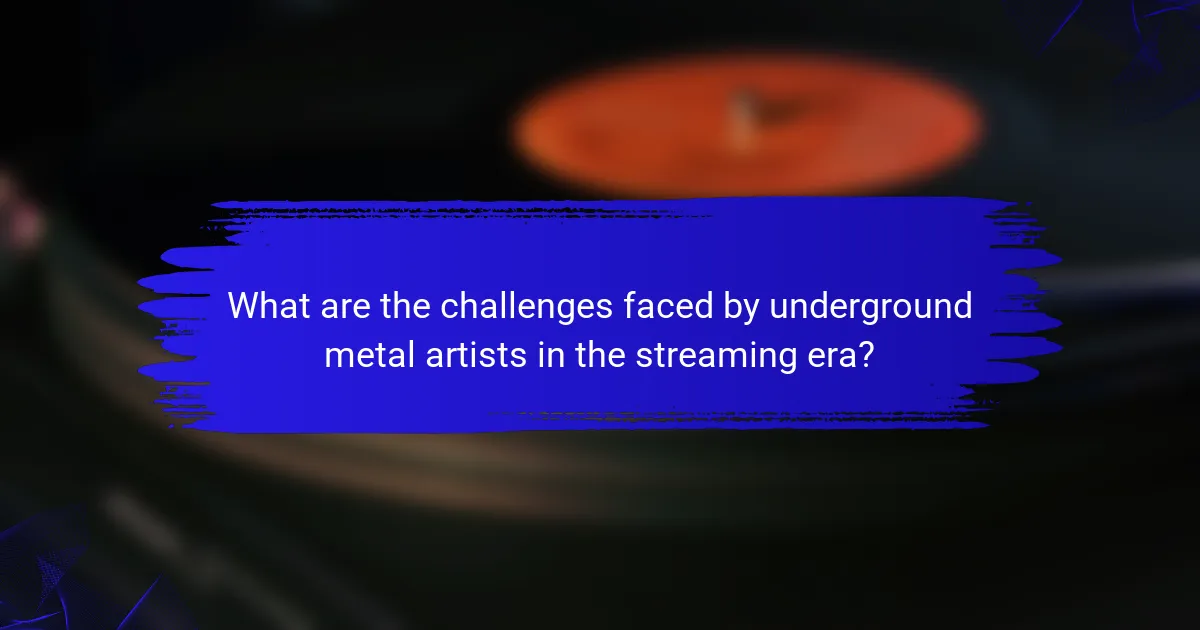
What are the challenges faced by underground metal artists in the streaming era?
Underground metal artists face significant challenges in the streaming era, including limited visibility and revenue. Streaming platforms often prioritize mainstream artists, making it difficult for underground musicians to gain traction. Additionally, the low payout rates from streaming services hinder financial sustainability, forcing many artists to seek alternative income sources. The oversaturation of content on these platforms can dilute their unique sound, making it challenging to stand out. Furthermore, the reliance on digital marketing and social media can be daunting for artists without extensive resources or expertise.
How do algorithm-driven playlists impact exposure for underground metal music?
Algorithm-driven playlists significantly enhance exposure for underground metal music by connecting niche artists to broader audiences. These playlists utilize algorithms to analyze listener preferences, promoting lesser-known tracks alongside popular ones. As a result, underground metal bands gain visibility, leading to increased streams and potential fan engagement. This exposure can transform the landscape of metal music, allowing unique sounds to reach diverse listeners. Furthermore, the data-driven nature of streaming platforms enables artists to understand audience demographics, tailoring their marketing strategies effectively.
What are the common misconceptions about streaming and underground metal production?
Many misconceptions exist about streaming’s role in underground metal production. One common belief is that streaming platforms primarily benefit mainstream artists, neglecting underground talent. In reality, these platforms provide exposure and accessibility for lesser-known bands, allowing them to reach wider audiences. Another misconception is that streaming diminishes the quality of music production. However, many underground artists utilize advanced technology and resources to create high-quality recordings, often at lower costs. Additionally, some think streaming leads to lower revenue for artists. While streaming royalties can be minimal, they often supplement income through increased merchandise sales and concert attendance. Understanding these nuances helps clarify the true impact of streaming on underground metal music production.
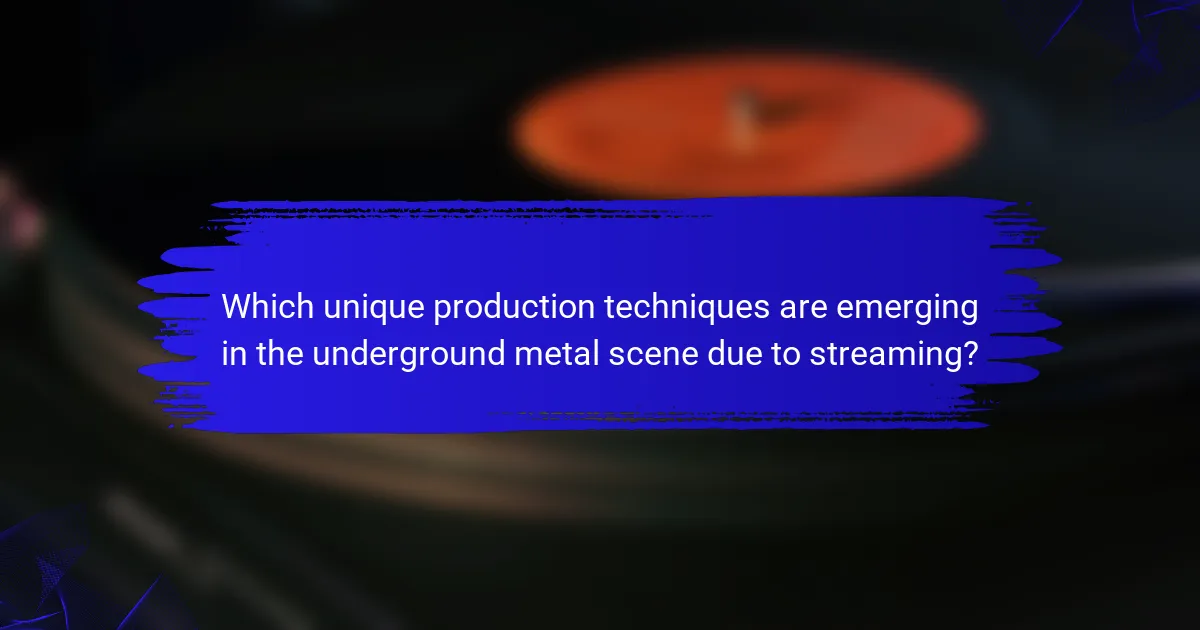
Which unique production techniques are emerging in the underground metal scene due to streaming?
Emerging production techniques in the underground metal scene due to streaming include DIY recording, remote collaboration, and innovative mixing methods. Artists increasingly utilize home studios to create high-quality tracks, leveraging affordable technology. Streaming platforms encourage experimentation with genre blending, leading to unique soundscapes. Additionally, the rise of social media allows for real-time audience feedback, influencing production choices. These shifts reflect a broader democratization of music creation, enabling diverse voices to thrive.
How are collaborations facilitated by streaming platforms changing music production?
Collaborations facilitated by streaming platforms are transforming underground metal music production by increasing accessibility and exposure. Artists can connect globally, leading to innovative sounds and diverse influences. Streaming services enable real-time feedback, allowing musicians to refine their work based on audience reactions. As a result, underground metal bands can leverage these platforms to reach wider audiences and secure collaborations that enhance their creative output.
What innovative marketing strategies are underground metal artists utilizing on streaming services?
Underground metal artists are leveraging innovative marketing strategies on streaming services by utilizing social media engagement, direct fan interactions, and exclusive content releases. These methods enhance visibility and build dedicated fanbases.
Social media platforms, like Instagram and TikTok, allow artists to showcase behind-the-scenes content, creating a personal connection with fans. Additionally, artists are releasing singles or EPs exclusively on streaming platforms to generate buzz and anticipation.
Collaborations with other underground artists can expand reach and introduce new audiences. Live-streamed performances and Q&A sessions on platforms like Twitch or YouTube further engage fans and create a sense of community.
By embracing these strategies, underground metal artists can navigate the competitive landscape of streaming services effectively, ensuring their music reaches a broader audience.
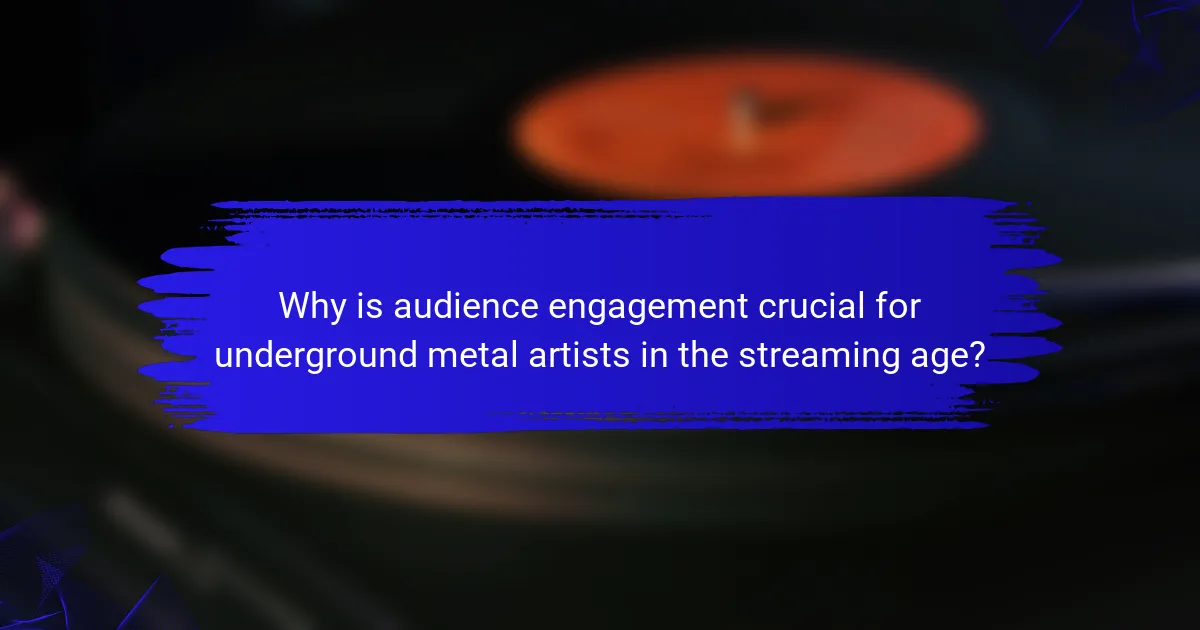
Why is audience engagement crucial for underground metal artists in the streaming age?
Audience engagement is essential for underground metal artists in the streaming age because it fosters community and drives listener loyalty. In a saturated market, artists must connect personally with fans to stand out. Engaged audiences are more likely to share music, attend shows, and support merchandise sales. Moreover, platforms like Spotify and Bandcamp reward artists with higher visibility when they cultivate active listener relationships. This engagement can lead to unique opportunities, such as collaborations and festival appearances, enhancing an artist’s profile in the competitive landscape of streaming.
How do fan interactions through streaming platforms impact music production decisions?
Fan interactions through streaming platforms significantly influence music production decisions in underground metal. Artists often adapt their sound and style based on feedback and engagement metrics, shaping their creative direction. Streaming data reveals listener preferences, guiding production choices like song length and instrumentation. Additionally, direct fan interactions can inspire thematic elements in lyrics and album concepts, fostering a collaborative environment. This dynamic relationship between fans and artists ultimately drives innovation within the genre, allowing underground metal to evolve in response to audience demands.
What metrics should underground metal artists track to gauge streaming success?
Underground metal artists should track metrics like listener growth, engagement rates, playlist placements, and revenue from streams. These metrics provide insights into streaming success and audience reach.
Listener growth indicates the increase in unique listeners over time, reflecting the effectiveness of promotional efforts. Engagement rates, measured through likes, shares, and comments, show how well the audience connects with the music. Playlist placements can significantly boost visibility, as being featured on popular playlists exposes the music to broader audiences. Revenue from streams offers a tangible measure of financial success and sustainability in the industry.
By focusing on these key metrics, underground metal artists can effectively gauge their streaming success and make informed decisions to enhance their music production and marketing strategies.
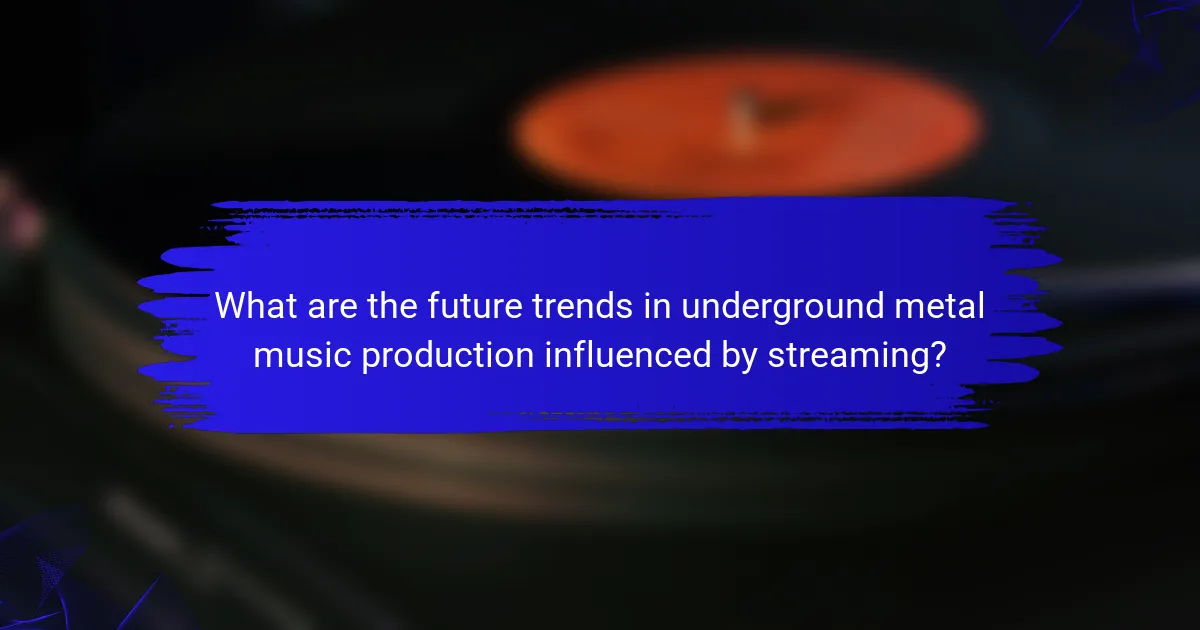
What are the future trends in underground metal music production influenced by streaming?
Streaming is shaping the future of underground metal music production by enhancing accessibility, collaboration, and genre fusion. Artists can now reach global audiences without traditional barriers. This democratization allows for innovative sounds and styles, as musicians collaborate across distances. Streaming platforms also provide valuable data analytics, helping artists understand listener preferences and optimize their production. Additionally, the rise of independent labels and self-released music is fostering unique sub-genres, further diversifying the underground scene. The trend towards shorter, more frequent releases caters to streaming consumption habits, shifting production strategies in this niche.
How might advancements in technology reshape underground metal production?
Advancements in technology are transforming underground metal music production by enhancing accessibility and creativity. Digital platforms allow artists to distribute their work globally without traditional barriers.
Innovative recording software and hardware enable high-quality production at lower costs. Artists can experiment with sounds and collaborate remotely, fostering unique styles.
Streaming services create new revenue models, offering exposure to niche audiences. Data analytics from these platforms help artists understand their listeners, shaping future projects.
As a result, underground metal is evolving, driven by technological advancements that empower artists and redefine music production.
What strategies can underground metal artists employ to thrive in a streaming-dominated market?
Underground metal artists can thrive in a streaming-dominated market by embracing innovative marketing strategies, engaging directly with fans, and leveraging digital platforms effectively. They should prioritize social media presence to build a loyal fanbase and utilize streaming services to distribute their music widely. Collaborating with other artists can enhance visibility and create unique content that attracts listeners. Additionally, artists can offer exclusive merchandise or experiences to monetize their fan engagement beyond streaming revenues.
What are the best practices for maximizing reach and revenue through streaming platforms?
To maximize reach and revenue through streaming platforms, underground metal bands should prioritize strategic promotion, audience engagement, and diverse revenue streams. Effective use of social media enhances visibility, while engaging content fosters community. Collaborating with influencers can expand reach, and leveraging merchandise sales alongside streaming income diversifies revenue. Regularly analyzing performance metrics helps refine strategies for better outcomes.